Feature Interview with Don Graham
January, 2006
Don Graham, a class A-1 PGA professional, began his career in the golf business after graduating from Wayne State College (Wayne, NE) in 1991. After working at various courses in Northeast Nebraska, Don became the head pro at Wild Horse Golf Club in the fall of 1999. He lives in Gothenburg, NE with his wife and four kids.
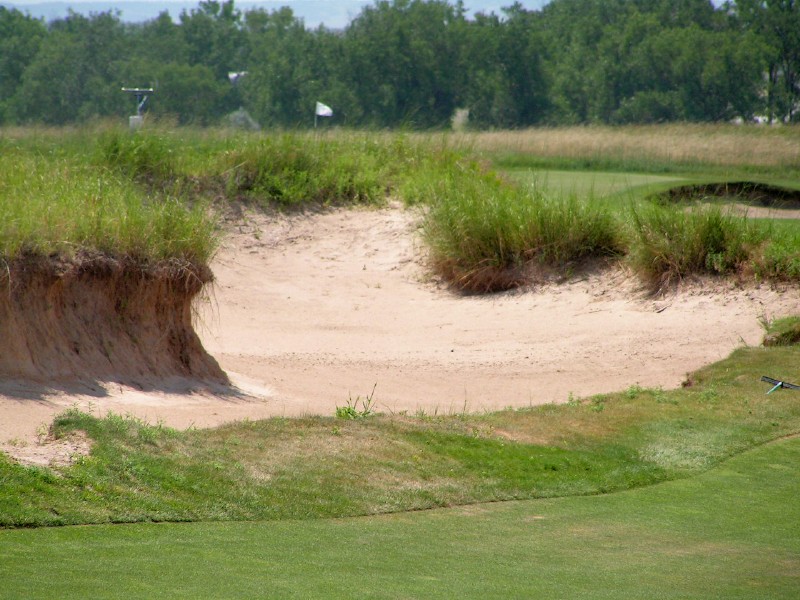
The wind, sandy soil, and excellent golf course architecture conspire to make Wild Horse one of the most fun courses to play in the United States.
Describe the location and property that Wild Horse Golf Club occupies.
The location of WH is one mile north and 1.5 miles west of the town of Gothenburg Nebraska. The property that the golf course sits on used to be used to graze cattle. The soil is very sandy and could be considered a part of the Sand Hills region.
Nebraska is a windy state and Bunker Hill did a great job in routing the holes so that they turn and twist in all directions. What is a particular example of the wind influencing play?
The par 3 9th hole plays around 155 yards, and I have hit everything from 3 iron to Sand Wedge. Not only does the wind effect the yardage each hole plays but it effects the short game even more. A down wind flop shot over a bunker to a green that plays very hard and very fast can cause a man to lose his mind.
The Old Course at St. Andrews is famous for its fairway bunkers, i.e. bunkers surrounded by fairway. More than any course in the United States with which I am familiar, Wild Horse possesses central fairway bunkers. How were these hazards initially received?
First time players at Wild Horse don’t seem to mind the fairway bunkers (unless they end up in one). First time players I think are to involved in trying to figure out the speed and slope of our greens to pay much attention to the fairway bunkering. As someone who has played the golf course a lot, I have come to respect what Dan & Dave were trying to accomplish with the fairway bunkers. The fairway bunkers on 2,3,7,16,17 and 18 really tell the golfer where the best place would be to hit his next shot.
Describe a hole with one or some of these fairway bunkers and how they influence play.
Hole #3 has the most fairway bunkers on it. Two bunkers come into play on the tee shot, the play is to play to the right of these bunkers, this shortens this slight dog leg right. The 3rd and 4th fairway bunkers are placed slightly right of center of the fairway at 150 and 100 yards out respectfully. A 5th bunker is placed 10 yards shy of the green slightly to the left of center. To the left of this bunker is a good bail out area for your ball to end up. If you want to attack this green on your second shot you must hit the ball up the right side, the natural lay of the land will bring your ball back to the green. The problem with this is your hitting a 220 yard to 240 yard shot into a 10 yard wide landing area.

The bunker in the foreground is 100 yards shy of the middle of the 3rd green and the one further up is 10 yards shy of the front of the green. Appreciating the right to left slope around the green helps the player determine the best playing angle.
The Old Course at St. Andrews is also famous for its greens that slope from front to back. The 4th and 7th are just such greens at Wild Horse. How do such greens influence how you play these respective holes?
Both the 4th and 7th holes play predominately down wind. Add that to the fact that both greens slope from front to back and you can see why you need to bring your bump and run game with you. Another outstanding design feature of Dan and Dave’s on the 7th hole is the fairway bunker directly in the center of the fairway. Another green side bunker to the left of the green tells the golfer I need to hit my drive down the right side of this fairway. Hopefully by the 7th hole the golfer has realized especially downwind that he’s not going to throw a lob wedge up in the air from 60 yards and hold any green here.
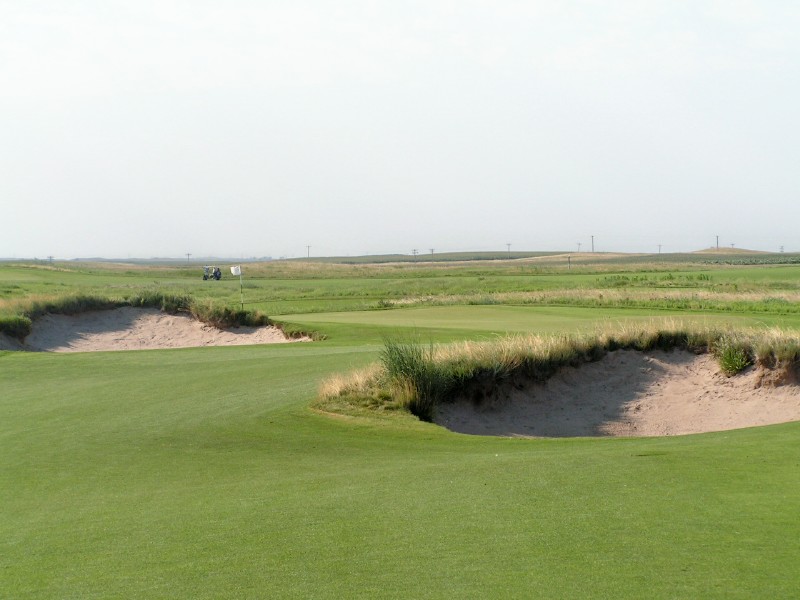
Downwind and with the green running away, getting close to this hole location at the 7th is endlessly vexing.
Is there a particular hole that continually surprises contestants in local events?
The 15th hole at Wild Horse continually surprises contestants as well as myself at virtually every event that we have. On paper it only plays 342 yards from the Championship tees. 3 bunkers guard the landing area of your tee shot, about 100 yards from the green. 2 bunkers also guard the green, one deep bunker guards 80% of the front of the green, and another guards about 60 % of the back of the green. At first glance you would think the play on this hole would be to hit a 230 yard shot at the bunker on the right side of the fairway, this leaves you with a 110 yard approach shot. However even at only 110 yards the approach has to land over the front greenside bunker and stop on a hard fast surface that is only 20 paces wide from this angle. The play on this hole is to hug the very left side of the fairway and hit the ball 260 yards from the back tees. This gives you an angle at the green that you don’t have to carry the front bunker. We held State Match Play here this year, and the 15th at Wild Horse rated as the third hardest hole that week.

After having driven within 40 yards of the 15th green, John Morrissett couldn't control his approach to the narrow green and is on his way to a sloppy six.
Like the great Pine Valley and Crystal Downs, Wild Horse possesses several sub-375 yard holes of outstanding quality. You have already spoken as to the 7th and 15th holes. Please describe the 5th hole.
The 5th hole at Wild Horse is a very unassuming par 4. The hole usually plays down wind and is only 367 yards from the back tees. Simple right, wrong this hole is a monster. The green is small and bowl shaped, any time the flag is on the right side of the green the hole plays harder. A large mound which is higher than the flag stick guards the right side of the green, on this mound are several fingers of sand that are played as a natural waste area. If your approach shot just clears the mound it will hit on the down slope and carum of the back of the green. The best way to play the hole is to hit your approach to the middle of the green and try to make a 20 footer for birdie. If you feel adventurous over the very right side of the mound that guards the front of the green there is a flat landing area about 10 feet wide by 15 feet long if you can land your ball in this area your ball will gently role to the left down a hill towards the hole. The thing that makes this shot fair is the fact that with a good drive you will have a sand or lob wedge in your hand. One of the most beautiful things about Wild Horse is that every hole can be played many different ways while still obtaining the desired results.
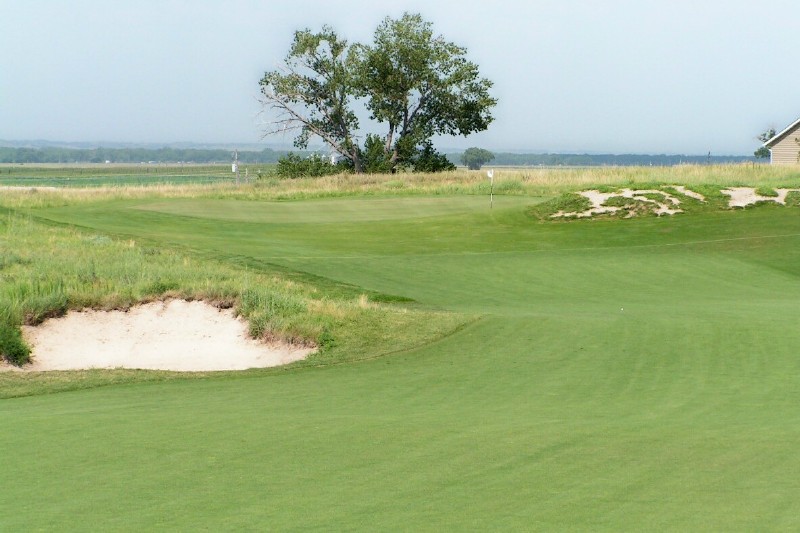
Though the fairway is wide, the best angle into the green is from the left side, just where Bunker Hill placed a fairway bunker. A tee ball pushed to the right leaves an approach over a mound dominated by scar bunkers.
Speak to the challenge of the approach shot to the bunkerless 10th green.
The 10th hole is a dog leg right 408 yard par 4 from the back tees that plays into the predominant wind. The landing area of your drive although very generous is the most undulating fairway on the course. So now your hitting dead into the wind from an awkward lie 150 yards or so from the green. The green is two tiered sloping back to front. If the pin is on the front tier and the wind is blowing at all you can not be on the back tier and putt your ball and keep it on the green. On both sides of the green are collection areas for errant approach shots, i.e. if you miss right or left slopes will carry your ball farther from the green. Add all these factors together and you can see why in my opinion the 10 hole approach shot is the hardest on the course.
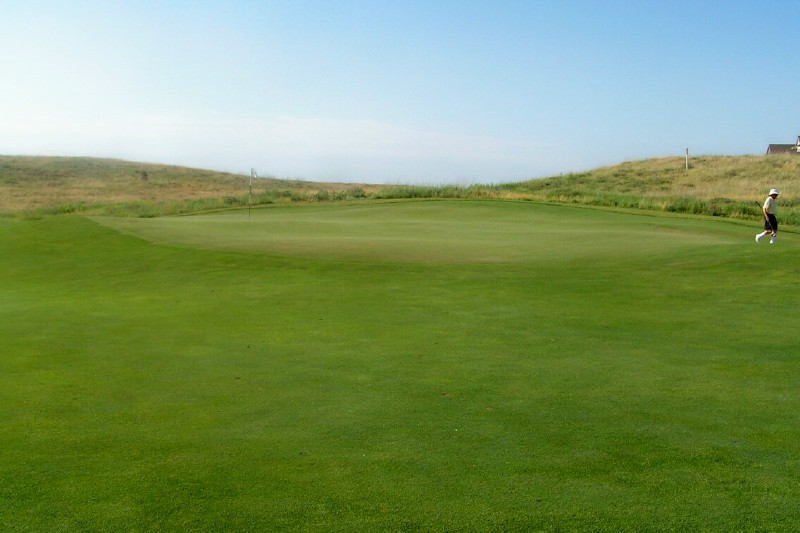
The back to front tilt of the green, the firm playing conditions, and the wind help make the 10th green an elusive target.
Describe a favorite one shotter and what you like so much about it.
Wild Horse has four fantastic par 3 holes. The 11th is a short one shotter that plays more difficult than it looks, but my favorite par three is number 13. Number 13 to me starts as your walking off #12 green. If you have never played WH before you get in your cart and head up this big hill to #13 tee box, when you reach the zenith of the hill you see a very long very redan looking hole. The green is the largest on the course at 5,000 square feet. Two bunkers guard the left side of this green that plays 208 yards from the back tees dead into the predominant wind. State Stroke play was held here 3 years ago and I saw the same guy with no wind on Thursday hit 5 iron, on Saturday with a very robust wind hit Driver. The green slopes from right to left, if you hit a good enough shot to reach the green you are still not guaranteed par. I divide this green into thirds, the front third slopes from back to front, the middle third is fairly level and the back third slopes from front to back. You can see why 2 putting this hole can be quite a challenge.

The large 13th green with its right to left sweep lies on the far side of a valley.
Please describe a favorite green at Wild Horse and what you like about it.
My favorite green at WH is on number 1. The green has a fairly large mound right in the center of it, kind of giving it a two tiered appearance. What makes it my favorite green is the different ways you can putt at the hole. I was playing golf a couple of months ago with some members from Omaha. The pin was up in the front right of the green. We had a team match going that was tied after 18, so we went back to #1. My partner lost his ball on the drive and I had hit my approach shot onto the back left of the green. Our opponents were safely on with 15 footers for birdie. My opponents knowing that I had to hit my putt over this mound figured I would be lucky to keep my first putt on the green. With my partners ball in hand I decided I had nothing to lose. I decided to avoid the mound in the middle of the green and putt the ball of the left side of the green where it would slope back to the hole and hopefully get close. After telling the opposition of my plan and getting a few laughs, I proceeded to putt the ball off the green, watch it turn back onto the green using the slope and proceed to go into the hole, for a routing birdie. Needless to say our opponunents were quite stunned. There putts didn’t come close. Every shot at Wild Horse affords you and opportunity to go at it your own way, that’s the beauty of the place.
On a day in, day out basis, Wild Horse may play the firmest and fastest through the green of any course in the United States. What are the keys to achieving such optimal playing conditions?
Our grounds superintendent Josh Mahar does a wonderful job of keeping the course at an optimal playing level. He does this by top dressing greens and approaches every two weeks. It is a very light coat of sand that he puts down, so it doesn’t affect play. Josh also aerates the fairways twice a summer which really seems to help our situation as far as compaction goes.
Please speak as to how Bunker Hill’s design allows for the ground game.
The ground game is an integral part of the Bunker Hill Design. All greens at Wild Horse are either protected by bunkers or large mounds. If the green is protected by a bunker, your obvious best position is at an angle to avoid having to hit over the bunker on your approach. Hole #15 is the perfect example of this. If you hit your drive to the right side of the fairway or short, you must hit over the front green side bunker. If you hit your drive left and long, you may now avoid that bunker and play a bump and run approach to this green. You can get away with hitting high approach shots into these greens, but if you want to score well you need to learn how to keep the ball on the ground.
Does that mean that Wild Horse Golf Club, unlike so many modern courses with multiple water hazards and forced carries, is also a great place for families to enjoy a game?
I would agree if you keep your ball in the fairway and out of the rough. Our very generous fairways are surrounded by natural prairie grasses. Some of these prairie grass areas can reach higher than three feet tall and can be very dense, making it very difficult, if not impossible, to find a bad shot. If you don’t hit it very straight you could spend a lot of time searching for balls.
Please give an example of how a specific hole plays equally well whether it is downwind or into the wind.
Hole #10 at Wild Horse is my favorite hole. No matter if the wind is behind you (out of the north) or into your face (south), this hole is a monster. No matter what direction the wind is blowing, your approach shot needs to end up on the correct tier of this two tiered green. If the wind is behind you, the landing area becomes smaller because your ball can run through this right dog leg fairway. If you hit a good drive in the fairway, you should be between 120 and 150 yards from the green. The green is slightly elevated and guarded by mounds on both sides. So keeping an approach shot on the front tier of this green is very difficult. If you are playing into the wind your approach will be from 150 to 200 yards from the green. Sometimes an approach shot that finds the back of this two tiered green will not stay on the green with your putt back down the hill with the wind behind you. Again, another hole that plays different every time you play it.
What is an example of Wild Horse being first and foremost a ‘position course’?
I’ve spoken about holes 5,7 and 15 a lot so I’ll chose hole 14 for this question. Hole #14 is a very reachable par 5. When you are on #13 tee box you can look back west at #14 green to see where the flag is. This will tell you which side of #14’s monstrous fairway you need to hit your tee shot. If the flag is in the middle or on the right side of this green, you can hit your drive anywhere but hitting it down the left hand side gets you closer to the hole. If the flag is on the left hand side and you want to go at the stick in two, you must hit your drive down the right hand side. If there is no wind and you hit a 250 yard drive you will have less than 200 yards left to the green. From the fairway, the left hand side of the green is protected by a huge greenside bunker. The middle of the green is protected by a four foot mound that will send your ball left into the green side bunker if not careful. To the right of the green is a mound that will actually carry your ball left onto the green.
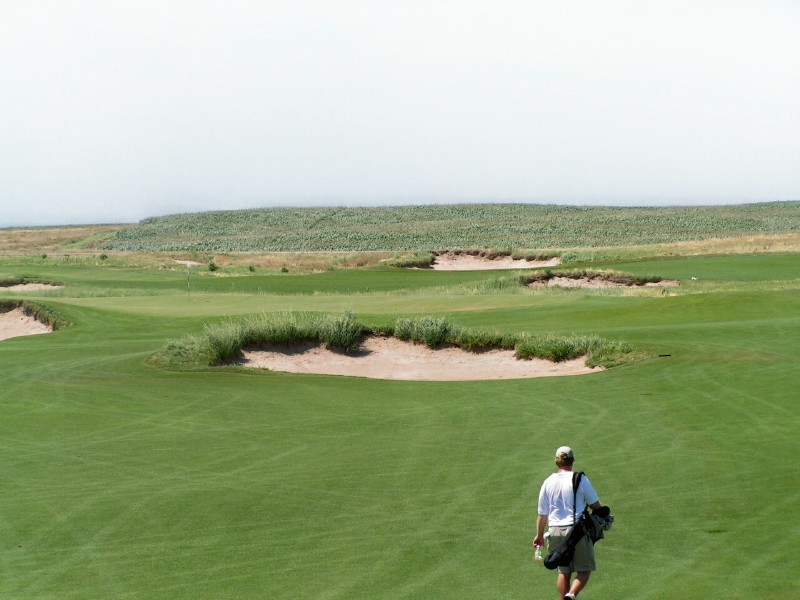
The large bunker 60 yards short of the 14th green plays a key role in one's second shot. A deep bunker just over the green makes this day's back hole location particularly tricky.
Since the course opened in 1999, has Bunker Hill made many changes to the course?
Not much has been changed on the course since 1999. New tee boxes have been built on Holes 1,9,14 and 17. All the new tee boxes opened in 2005.
Is there a hole that you feel is underappreciated, especially by first time visitors?
I feel that, architecturally, all 18 holes might be underappreciated by first time visitors. The comments that I hear from most players are, “the greens are so fast, everything plays so hard” ” the fairways are perfect” and my favorite “is it always this windy?”. I have played the golf course 1000 times or more and I am not sure I appreciate everything it has to offer. If I had to chose a hole it would be the 15th. A friend of mine recently built his house near the 15th hole. His reasoning was not the beauty of the location but the fact that he could get up every morning walk out his back door some 200 yards to the 15th tee box, and play that “******” hole until he figures it out. Now that’s Wild Horse.
The End








